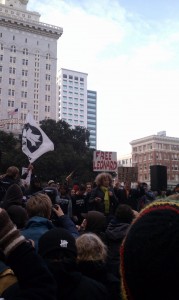On Monday, December 12th, thousands of people took part in a coordinated shut down of ports along the West Coast, including the port of Oakland here in the Bay Area where protesters successfully shut down the port for three consecutive shifts starting at 5:30am when 1,500 people came out to disrupt the morning shift. I took part in the afternoon rally and march to the port.
Why the ports?
The actions were carried out in solidarity with longshoremen port workers and truck drivers, in support of their long-time struggle against unjust treatment by companies that have a strong influence on port operations, in particular EGT (Export Grain Terminal) and Goldman Sachs, which owns a large stake in major port operator SSA Marine. Both EGT and Goldman Sachs have been involved in an ongoing battle with the International Longshore Workers Union (ILWU) around its members’ right to organize. Read more here.
Aside from showing support for port workers’ rights, the port shut downs were also intended as a means of economically disrupting the 1% by cutting into the economic profits of major corporations that depend heavily on port operations. The shut downs also symbolized a response to the nationally coordinated, brutal police repression that the Occupy Movement has faced in recent weeks. Around four thousand people took part in the afternoon march to the Oakland port on 12.12.11. Here’s a breakdown of what happened that afternoon and into the evening:
3pm
Hundreds of people gathered in downtown Oakland at Oscar Grant Plaza on 14th & Broadway, Iraq war veteran Scott Olsen who is on the long road to recovery from a serious head injury he sustained as a result of police violence in October spoke to the crowd followed by Angela Davis, an activist, scholar and retired professor from UC Santa Cruz. Watch the video of them speaking here.
4pm
The march leaves Oscar Grant Plaza for the port, led by Scott Olsen and Iraq Veterans Against the War.
5:30pm
An announcement is made that port operations for the evening shift have been shut down, people chant and cheer in celebration as the march continues into the port joined by another march of close to 2,000 people that left from West Oakland BART station.
7pm
A General Assembly was held to decide whether or not the blockade will be extended until the 3am shift. Occupy Oakland decided that they would extend the blockade if there were any instances of Occupy-related police repression or violence in other cities. Once news broke about San Diego and Long Beach where several protesters were arrested and in Seattle where police used pepper-spray and concussion grenades, the Occupy Oakland website posted “Based on verified police repression at Occupy Seattle, Occupy Houston, Occupy Long Beach and Occupy San Diego, the port blockade in Oakland will continue. Next shift is at 3am and we need as much people as possible!” About 400 people stayed and successfully shut down the 3am shift.
While there are mixed views about the action on Monday between labor union leaders and activists on whether or not it was right to shut down the ports for a day, many rank and file workers have expressed that although they are disappointed to lose a portion of their wages, they recognize the occupiers’ genuine intention to raise awareness around port worker mistreatment and the union-busting practices of corporations like Goldman Sachs who are part of the 1%. Port truck drivers published an open letter in response to the port occupations on Monday on the Coalition for Clean and Safe Ports website.
I think that the higher than expected turnout at the port shut down on Monday speaks to the continuing vibrancy of the Occupy movement and a potential shift towards coordinated, issue-specific actions that call attention to the many problems that are shared by the 99%.
It was inspiring for me to stand beside so many people coming from different experiences who are joining together under a common goal – changing the system to better the lives of the people who support it.

